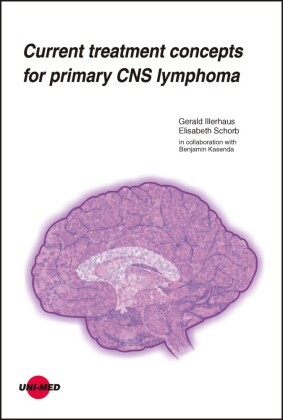
Current treatment concepts for primary CNS lymphoma
| Verlag | Uni-Med |
| Auflage | 2021 |
| Seiten | 80 |
| Format | 17,2 x 0,9 x 24,9 cm |
| Gewicht | 287 g |
| Artikeltyp | Englisches Buch |
| Reihe | UNI-MED Science |
| ISBN-10 | 3837424200 |
| EAN | 9783837424201 |
| Bestell-Nr | 83742420A |
Primary CNS lymphomas (PCNSLs) are defined as non-Hodgkin lymphomas which, at the time of diagnosis, are located exclusively in the brain parenchyma, in the meninges and / or in the spinal cord or in the vitreoretinal area. They occur much more frequently in immunoincompetent patients than in immunocompetent patients. As a rule, it is an aggressive, diffuse large-cell B-cell lymphoma, in which the median survival time without therapy is only a few weeks to months after diagnosis.The therapeutic spectrum of PCNSL is limited by the difficulty of crossing the blood-brain barrier. If this is the case, however, the chemosensitivity is high. Due to the rarity of this tumor disease, most studies are based only on small numbers of patients with limited informative value. Nevertheless, in the last few years, it has been possible to establish promising curative therapeutic approaches that are based on induction and subsequent consolidation therapy and enable high remission rates and several years of progression-free survival.All of these aspects are taken into account in this monograph, which summarizes the current knowledge on the PCNSLs in a compact and informative way.
Inhaltsverzeichnis:
1. Introduction 122. Epidemiology 143. Pathogenesis 184. Clinical picture 205. Diagnostics 245.1. Imaging techniques 245.2. Biopsy and histopathology 265.3. Neurocognitive evaluation 275.4. Staging 305.4.1. Lumbar puncture 305.4.2. Ophthalmic examination 315.4.3. Bone marrow biopsy 325.5. Further investigations 326. Prognostic factors 367. Therapy 387.1. Criteria for assessing the therapy response 387.2. Therapeutic principles 397.3. Induction therapy 407.3.1. Methotrexate-based chemotherapy regimens 407.3.2. Methotrexate-based polychemotherapy 407.4. Consolidation strategies 417.4.1. High-dose chemotherapy and autologous stem-cell transplantation (HDC/ASCT) 417.4.2. Intensive conventional chemotherapy without ASCT 427.4.3. Radiotherapy 427.4.4. Maintenance treatment 437.5. Therapy in relapse or refractory disease 447.5.1. Renewed chemotherapy for recurrent PCNSL 447.5.2. HDC/ASCT 457.5.3. Palliative radiotherapy 458. New drug substances 488.1. Lenalidomide 488.2. Ibrutinib 488.3. mTOR inhibition 498.4. PD-1 targeted therapy 499. Therapy for special patient groups 529.1. Elderly patients 529.2. Immunosuppressed patients 529.3. Patients with ocular infestation 539.4. Patients with leptomeningeal infestation 539.5. Patients with kidney failure (without MTX) 5310. Supportive therapies 5610.1. Steroid medication 5610.2. Prophylaxis against infecions 5610.3. Prophylaxis for epileptic seizures 5610.4. Physiotherapy and rehabilitation 5611. Risks of toxicity 5811.1. Criteria for toxicity 5811.2. Organ toxicity 5811.3. Infections 5811.4. Leukoencephalopathy 5812. Aftercare 6013. Summary and outlook 6214. References 6415. Abbreviations 74Index 76
